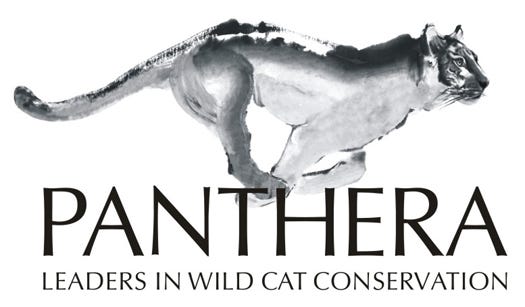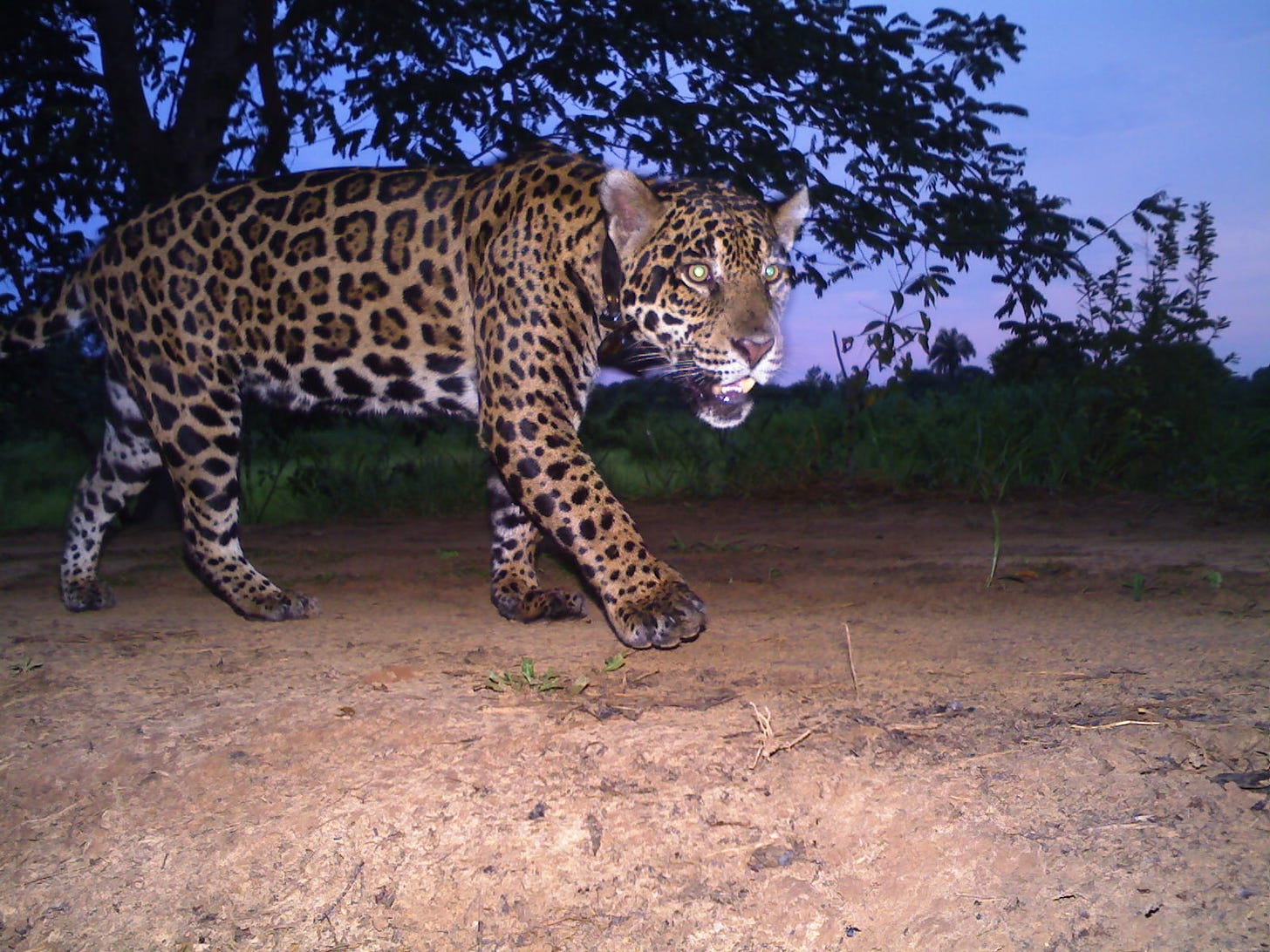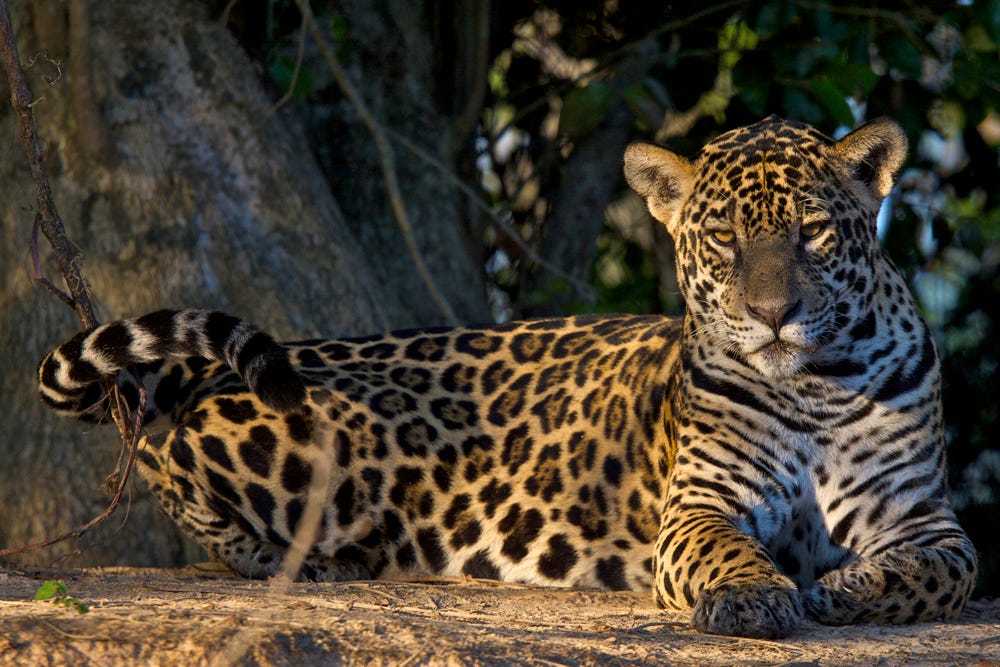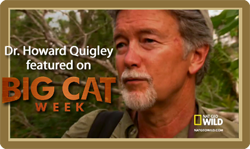By Jordan Schaul | National Geographic | October 28, 2013
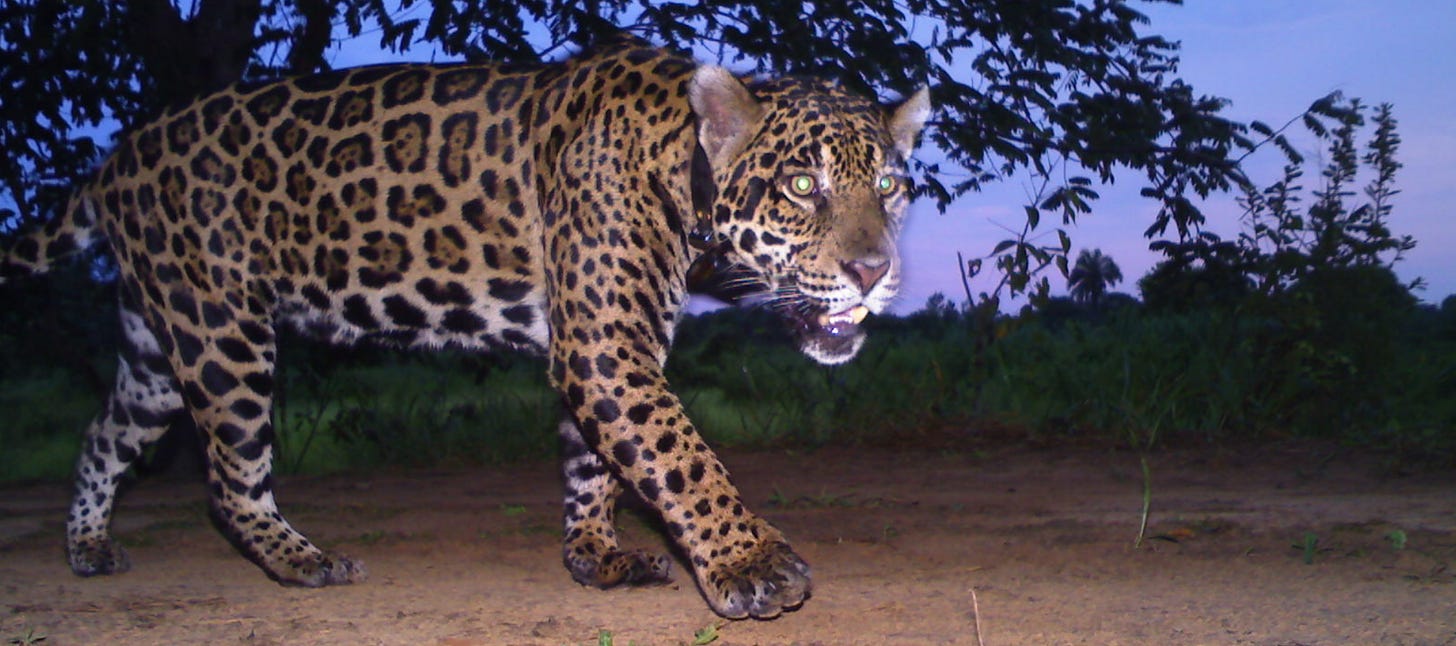
Dr. Jordan Schaul interviews Dr. Howard Quigley of Panthera about the status of the jaguar. Like many apex predators, the jaguar serves as a national symbol for multiple countries, where it is revered as the most powerful and stealthy predator. The iconic wild felid is a member of the pantherine lineage of the cat family—Felidae. Felidae includes the true big cats (i.e. lion, tiger, leopard, snow leopard, and the two species of clouded leopards).
The majestic spotted cat is the third largest cat species on the planet and the largest in the Western Hemisphere. It is, perhaps, a living legend, as the iconography of pre-Columbian Mesoamerican societies depicted the jaguar as a great warrior and hunter, as it is thought of to this day. In fact, the great Mayan hunters and warriors adorned themselves with jaguar pelts and other jaguar biofacts; These noble and respected tribal leaders were considered to possess a feline soul in regard for and in recognition of deities associated with the great cat.
Although many modern-day societies hold the big cat in high regard, the presence of the jaguar is not so appreciated by all. Charismatic to many, the formidable predator is increasingly perceived as a threat to the livelihoods of ranchers and it is sometimes fairly and appropriately implicated in the loss of livestock, which they coexist with through much of their current range.
The jaguar may indeed have emerged as a pest species, and its involvement in human-cat conflict may be on the rise, but only as a result of anthropogenic stressors. These include activities and events such as the depletion of their prey base and the continued loss of habitat. Sadly, many are hunted in retaliation for the presumed or actual killing of livestock.
I caught up with Dr. Howard Quigley (Executive Director of jaguar and cougar programs) of Panthera, the most renowned organization in the world dedicated to large felid conservation. Dr. Quigley was returning from Brazil, presumably the Brazilian Pantanal, and graciously agreed to participate in the following interview to update Nat Geo News on the status of the imperiled jaguar.
Jordan: Welcome back to the states and thanks for participating in this interview. I wanted to first get an overview of Panthera’s innovative Jaguar Corridor Initiative program. Essentially corridors are designed to link the core habitats for a given species. Your teams have managed to link habitat across jaguar range-countries from Argentina, near the tip of South America, to Central America, almost as far north as the northern portion of the cat’s historic range in the Southwestern US. Can you elaborate on this monumental effort aimed at protecting the worldwide population of jaguars and explain a little bit about what comprises the core habitat for the jaguar?
Dr. Quigley: Thanks, Jordan. It’s good to be back, but it’s always great to be in jaguar habitat, too. We have so many inspiring activities and inspiring people working on the issue of jaguar connectivity, that it’s just great to be out and immersed in it!
The simplest way to describe the JCI is that its jaguars showing us the way! By that, I mean that we looked at jaguar genetics, and we looked at the landscapes in which jaguars exist. The genetics of jaguars say that they are all one species; there are no subspecies, which is truly incredible for a land mammal that covers so large a range, from Arizona to Argentina. Thus, we saw our conservation mandate: keep them connected! So, the next question is – given the fact that they have been doing SO well moving and breeding and not succumbing to many of the barriers that fragment populations and make species and subspecies – how do we help maintain this connectivity? So, you might say, jaguars showed us their genes to tell us about themselves, and now we’re trying to define the connections – or corridors – that make the Jaguar Corridor. For this, we’re conducting a variety of field studies to more precisely define the conservation priorities, across the entire jaguar range.
Jordan: I understand that your team is working in the majority of the 18 countries in which extant (living) populations of the jaguar currently exist, but not all of them. Is Panthera limited by resources or have you prioritized core habitat within range countries that require the most attention to facilitate the linkage of habitat throughout the jaguar’s range?
Dr. Quigley: Well, I have to chuckle a bit, because we are always limited by resources, primarily monetary resources. Jaguars just don’t get the attention that African lions or tigers get, nor the money. We have such dedicated and committed people working on jaguars; this is not our limitation. With the limitations, we have to have a strategy that prioritizes topics and locations. Thus, we focus on the “backbone” of the Jaguar Corridor, and we can’t get diverted. Otherwise, we dilute our effect in jaguar conservation, in defining the corridor. We are working to find the core, the major highway, of jaguar connectivity, without taking too many side roads. So, we might participate or advise on work in Ecuador, for instance, but we don’t have an office there. Or, we might provide advice in the Mexican Yucatan region, but we don’t devote core budget resources there because it’s a peninsula, a dead end on the Jaguar Corridor. We want to find the core of the corridor, and begin to save it. Then, we’ll work out to the edges when we have the resources to do so, and the core is secured. It sounds a bit brutal, but it is the reality of conservation and the limited resources available. Right now, we are making sure we have mapped the backbone, the core, and then we’ll try to expand if the resources are there.
Jordan: How prevalent would you consider the jaguar regarding its implication in human-feline predator conflict compared to other species of big cats. Is it even a fair comparison? Are there region-specific issues within Latin America that first require consideration on a geospatial level? Do these issues transcend geopolitical boundaries?
Dr. Quigley: OOOOhhh, they SO transcend geopolitical boundaries! …especially with regard to human conflicts. Jaguars are not “man-eaters”, like tigers, rarely attacking humans. But, like African lions, like snow leopards, and so many predators, they find it difficult to live in a landscape altered by humans that reduce their available prey, and providing vulnerable alternative prey – cattle, goats, sheep – and not take advantage of that. And, in Latin America, the livestock industry continues to expand, and people continue to take jaguar prey in an unsustainable fashion in so many areas. But, we’ve stepped in with a very aggressive program that offers solutions to ranchers – really simple solutions – that will reduce the conflict. And, we’re working with local communities to measure hunting impacts and develop sustainable harvest approaches to native wild species. The solutions bridge the political boundaries, as do the causes. That’s why we work within countries and between countries to make jaguar conservation happen.
Jordan: I think our readership is often fascinated with how apex predators compare if you can compare them. In my opinion, comparing predator-human interactions provides a perspective that people from far and wide can relate to. For example, you do some outreach work in Brazil’s Pantanal or have in the past to educate ranchers on ways to coexist with jaguars. This involves some capacity building. I suspect that in North America people would be surprised that one of the main threats to cougar (AKA mountain lion) populations is similarly an issue of lack of public awareness.
As one of the world’s most esteemed authorities on mountain lions, you have found that the general public is largely uninformed about these cats, at least in regard to our capacity to coexist with them here in North America. Perhaps we should be careful not to criticize our South American friends because we have much to learn about mitigating human-cat conflict here in North America with regard to human-mountain lion conflict. After all, I presume the jaguar, once shared habitat (exhibited syntopy), with the mountain lion here in California or at least overlapped in range (exhibited sympatry).
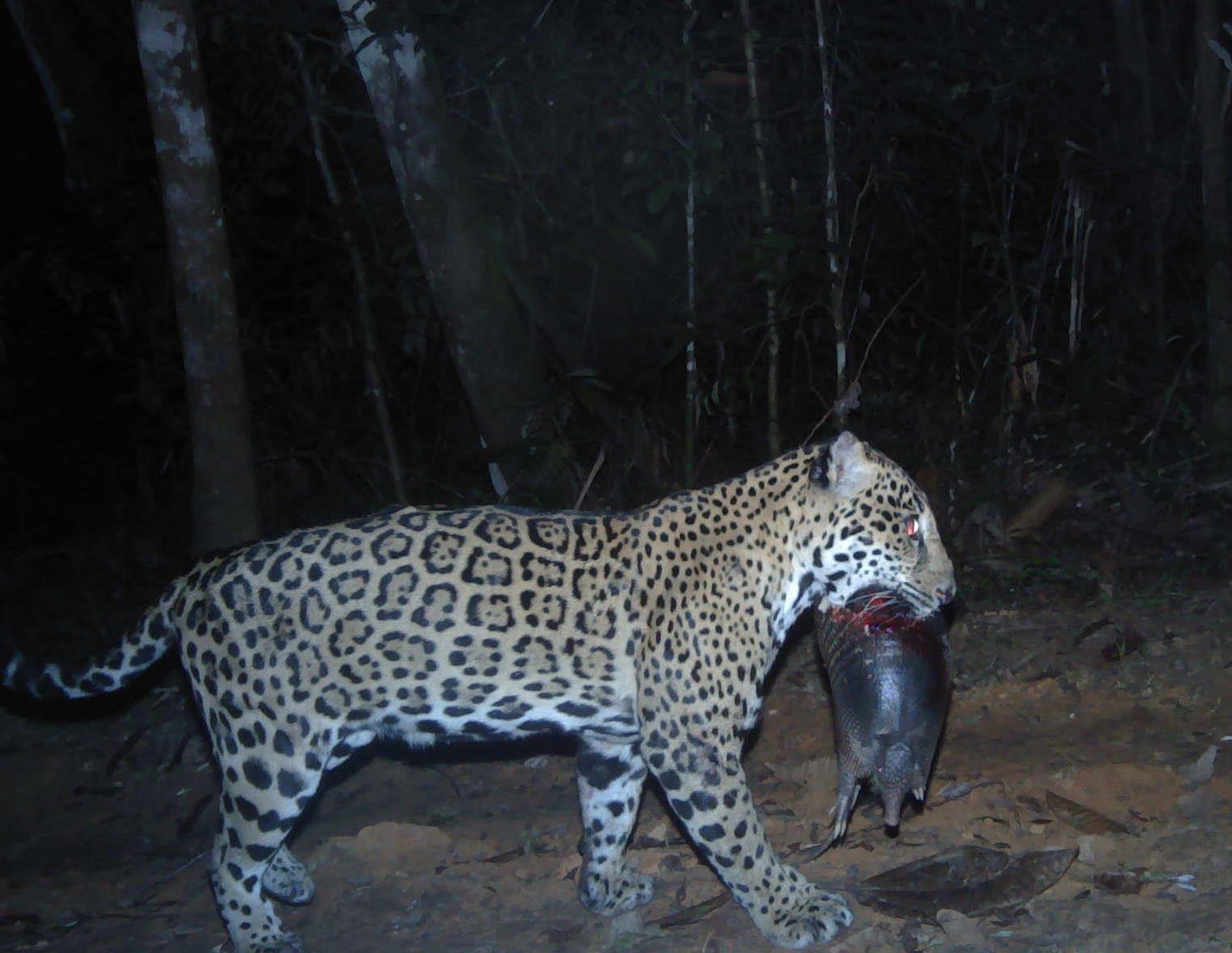
I’ll defer to you on these cats in regard to whether or not they were at one time syntopic carnivores in North America, as I think of them in South America. Please correct me if I am wrong. But more to the point we are left with a population of mountain lions in need of protection up here in California. And I think that compared to issues up here livestock ranchers are probably much more familiar with the behavioral ecology of jaguars than Californians are with cougars. Again, I could be wrong, but could you share some of your sentiments or concerns or otherwise comment on this topic?
Dr. Quigley: No, you’re absolutely right, Jordan, jaguars, and mountain lions used to live side-by-side in the U.S., and that’s a great question and observation about the comparison between North and South America and how we have handled our relationship with our big cats. Remember, we nearly wiped out mountain lions in the U.S., although they are making an incredible recovery. Still, yes, we’ve found that people are SO uninformed about this species…and ha!, you might be right: the information ranchers have on jaguars, generally, is better than most Californians have about their own mountain lions. This is a very difficult dilemma for conservation in California, but it gives us hope that we can start with ranchers in Brazil or Honduras, or Panama and at least have a base of understanding. AND, when we come up with solutions that reduce the killing of livestock by jaguars, we make a lot of friends. And, we find that most ranchers don’t want to kill jaguars!
Jordan: Panthera is particularly fond of using camera traps to help census large felids. It seems that this tool has not caught on as widely as some other and older methods for evaluating the abundance and distribution of some species of elusive and primarily solitary large carnivores. Can you talk about why you find camera traps so effective?
Dr. Quigley: You’re right, Jordan. Camera traps have become our tool of choice in jaguar studies and across our species programs. Most wild cats are very secretive. Prior to the invention of camera traps, we were limited to two extreme parts of what you might call “the data collection spectrum”. I mean, we either had to rely on the sign that they left in the jungle or forest, like tracks, or we went to the other end of the spectrum, to capture and radio-telemetry. Camera traps have helped fill that void, and usually without affecting the study subject, without even touching the animal, be it a jaguar, a tiger, or whatever species. The added bonus in all this is that we get pictures of behavior, or we can analyze the photos for animal condition, and we get pictures of other animals that live with the wild cats, like their prey. This gives us a picture of the community that we just didn’t have before. We’re JUST starting to learn, really, about how to analyze these data for the tools of conservation. AND – one of the biggest bonuses is that we have tools for outreaching the information to the general public! This has had amazing results, really getting people involved in the conservation of the animals they can’t see.
Jordan: Panthera is entrusted with helping some of the world’s most charismatic megafauna. I imagine that you and your teams are all in the field with great frequency. So my question and it is more out of my curiosity, but if some of Panthera’s staff working with various subspecies of leopards, for example, have a need or the opportunity to share information outside of exchanging your own peer-reviewed publications do you have the opportunity or do you ever convene to do so?
In other words, and to perhaps clarify, are there too many human-dimension issues that are region-specific or landscape and species/subspecies specific that make such communication impractical or unnecessary with regard to working with the big cats. Or as a carnivoran (mammalian carnivore) biologist, do you find methods to study and conserve the wild felids to be fairly transferable or beneficial to helping your colleagues working with different cat species elsewhere in the world?
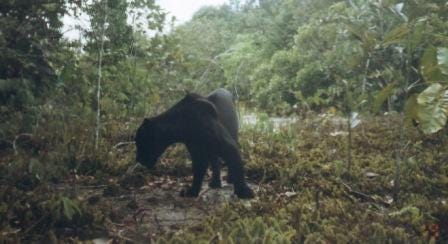
Dr. Quigley: Great question, Jordan, and certainly one that you understand, too, given your science background. There is ALWAYS room for more interaction and collaboration in our field. You can go to conferences, interact with colleagues online or in the office, but that “critical mass” of interaction is hard to find, especially for carnivorans, because we’re more rare than some of the other divisions in our field, like ungulate biologists or songbird biologists. But, at Panthera, we’re working very hard now to bring our own biologists together – with new software and cross-program strategy assessments – because, as you put it, these issues are largely “transferable” and we have common challenges for which we may be able to find solutions much more readily if we compare and contrast our work across programs.
Jordan: You shared with me earlier that your camera traps have recorded two melanistic jaguars in two different range countries for the species. I think I read that “black panthers” comprise 6% of the extant jaguar population, but you explained to me why there seems to be such a low representation of these mutant color morphs in the regions your team is working in. For some reason I thought the percentage reported in the literature was high, but are you surprised by this data and can you reiterate for our readers why the number of melanistic individuals reported by the camera trap data recovered is seemingly so low?
Dr. Quigley: I think the best way to describe answer this is, “we don’t know”, I’m sorry to say. I love it because it’s one of those intriguing questions that we haven’t sorted out. It doesn’t necessarily have a high value for conservation – as a pressing issue whose answer will hold the key to jaguar persistence, for instance. But, you never know. That’s the beauty of what we do in science, sorting out the reasons, the facts, and the pieces of the puzzles that make a species work. It can be SO complicated, and you never know when the explanation of one little aspect of a question about a species just might open up all sorts of answers and insights elsewhere in a species’ ecology.
Melanism is just one such intriguing question that we can’t fully explain in jaguars. Yes, jaguar melanism occurs at a very low rate in the species. Across our camera studies, I’m sure it’s less than the 6% you mentioned. On the other hand, we have few projects in the Amazon, where there seem to be more melanistic individuals. See, there’s a spatial component to the phenomenon that we don’t understand. And, it’s more complicated than that, and we only have a few of the pieces, and those pieces are not explaining melanism very fully yet. For instance, if melanism is controlled by a dominant allele – which has been suggested by genetic studies – then why don’t we see more melanism in the wild? Is the coloration less successful than the spotted coloration? Are melanistic individuals not surviving as well? We just don’t know, and we’ll keep putting the data together until we think we have more answers.
Jordan: Finally, what can people do to help big cats if they live in regions where they might actually interface with them or if they would like to help endangered felids remotely?
Dr. Quigley: Learn more about cats, and disperse your knowledge to others. And, if you have the chance to take action to help cats, please do! That’s what I’d tell people in cat country. And, if you have the ability and the means, please give, to Panthera and organizations truly advancing the conservation of wild cats. Around the world, with few exceptions, governments and agencies are able to do it all, to do what needs to be done to secure wild cats in the wild. NGOs and independent researchers and conservation biologists play critical parts in all of this. Panthera, NatGeo’s Big Cat Initiative, academic institutions, and a multitude of small NGOs around the world that we work with, all play such an important role, and they need support. There is SO much to be done, to make sure these species exist for the next generations, and they are such a measure and an emblem of our commitment to the environment. It’s about them, but it’s also about us, and how we want OUR environment to look like. A world with fewer wild cats would certainly be a less rich, less fulfilling, and less healthy world.
Panthera’s film on jaguar conservation
ABOUT NATIONAL GEOGRAPHIC SOCIETY
The National Geographic Society is a global nonprofit organization that uses the power of science, exploration, education and storytelling to illuminate and protect the wonder of our world. Since 1888, National Geographic has pushed the boundaries of exploration, investing in bold people and transformative ideas, providing more than 14,000 grants for work across all seven continents, reaching 3 million students each year through education offerings, and engaging audiences around the globe through signature experiences, stories and content. To learn more, visit www.nationalgeographic.org or follow us on Instagram, Twitter and Facebook.
MEET THE AUTHOR
Jordan Carlton Schaul With training in wildlife ecology, conservation medicine, and comparative psychology, Dr. Schaul's contributions to Nat Geo Voices have covered a range of environmental and social topics. He draws particular attention to the plight of imperiled species highlighting issues at the juncture or nexus of sorta situ wildlife conservation and applied animal welfare. Sorta situ conservation practices are comprised of scientific management and stewardship of animal populations ex-situ (in captivity / 'in human care') and in situ (free-ranging / 'in nature'). He also has a background in behavior management and training of companion animals and captive wildlife, as well as conservation marketing and digital publicity. Jordan has shared interviews with colleagues and public figures, as well as editorial news content. In addition, he has posted narratives describing his own work, which include the following examples: • Restoration of wood bison to the Interior of Alaska while (While Animal Curator at Alaska Wildlife Conservation Center and courtesy professor at the University of Alaska) • Rehabilitation of orphaned sloth bears exploited for tourists in South Asia (While executive consultant 'in-residence' at the Agra Bear Rescue Center managed by Wildlife SOS) • Censusing small wild cat (e.g. ocelot and margay) populations in the montane cloud forests of Costa Rica for popular publications with 'The Cat Whisperer' Mieshelle Nagelschneider • Evaluating the impact of ecotourism on marine mammal population stability and welfare off the coast of Mexico's Sea of Cortez (With Boston University's marine science program) Jordan was a director on boards of non-profit wildlife conservation organizations serving nations in Africa, North and South America and Southeast Asia. He is also a consultant to a human-wildlife conflict mitigation organization in the Pacific Northwest. Following animal curatorships in Alaska and California, he served as a charter board member of a zoo advocacy and outreach organization and later as its executive director. Jordan was a member of the Communication and Education Commission of the International Union for the Conservation of Nature (CEC-IUCN) and the Bear Specialist Group of the IUCN Species Survival Commission (BSG-SSC-IUCN). He has served on the advisory council of the National Wildlife Humane Society and in service to the Bear Taxon Advisory Group of the Association of Zoos and Aquariums (AZA Bear TAG). In addition, he was an ex officio member of the council of the International Association for Bear Research and Management. Contact Email: jordan@jordanschaul.com http://www.facebook.com/jordan.schaul https://www.linkedin.com/in/jordanschaul/ www.jordanschaul.com www.bicoastalreputationmanagement.com



